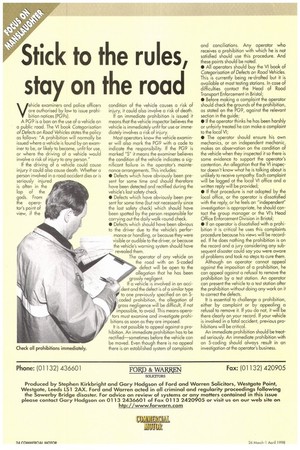Stick to the rules, stay on the road
Page 26

If you've noticed an error in this article please click here to report it so we can fix it.
Vehicle examiners and police officers are authorised by law to issue prohibition notices IPG9s). A PG9 is a ban on the use of a vehicle on a ,public road. The VI book Categorisation of Defects on Road Vehicles states the policy as follows: "A prohibition will normally be issued where a vehicle is found by an examiner to Le, or likely to become, unfit for use, or where the driving of a vehicle would involve a risk of injury to any person."
If the driving of a vehicle could cause injury it could also cause death. Whether a person involved in a road occident dies or is seriously injured is often in the lap of the gods. From the operator's point of view, if the condition of the vehicle causes a risk of injury, it could also involve a risk of death. If an immediate prohibition is issued it means that the vehicle inspector believes the vehicle is immediately unfit for use or immediately involves a risk of injury.
Most operators know the vehicle examiner will also mark the PG9 with a code to indicate the responsibility. If the PG9 is marked "S" it means the examiner believes the condition of the vehicle indicates a significant failure in the operator's maintenance arrangements. This includes:
• Defects which have obviously been present for some time and should therefore have been detected and rectified during the vehicle's last safety check.
• Defects which have obviously been present for some time (but not necessarilysince the last safety check) which should have been spotted by the person responsible for carrying out the daily walk-round check.
• Defects which should have been obvious to the driver due to the vehicle's performance or handling, or because they were visible or audible to the driver, or because the vehicle's warning system should have revealed them.
The operator of any vehicle on the road with an S-coded defect will be open to the allegation that he has been grossly negligent.
IF a vehicle is involved in an accident and the defect is of a similar type to one previously specified on an 5coded prohibition, the allegation of gross negligence will be difficult, if not impossible, to avoid. This means operators must examine and investigate prohibitions as soon as they are imposed.
It is not possible to appeal against a prohibition. An immediate prohibition has to be rectified—sometimes before the vehicle can be moved. Even though there is no appeal there is an established system of complaints and conciliations. Any operator who receives a prohibition with which he is not satisfied should use this procedure. And these points should be noted. • All operators should buy the VI book of Categorisation of Defects on Road Vehicles. This is currently being re-drafted but it is available at most testing stations. In case of difficulties contact the Head of Road Transport Enforcement in Bristol; • Before making a complaint the operator should check the grounds of the prohibition, as stated on the PG9, against the relevant section in the guide; • If the operator thinks he has been harshly or unfairly treated he can make a complaint to the local VI; • The operator should ensure his own mechanics, or an independent mechanic, makes an observation on the condition of the vehicle when they inspected it so there is some evidence to support the operator's contention. An allegation that the VI inspector doesn't know what he is talking about is unlikely to receive sympathy. Each complaint will be logged at the local VI office and a written reply will be provided; • If that procedure is not adopted by the local office, or the operator is dissatisfied with the reply, or he feels an "independent" investigation is appropriate, he should contact the group manager or the VI's Head Office Enforcement Division in Bristol; • If an operator is dissatisfied with a prohibition it is critical he uses this complaints procedure because his views will be recorded. If he does nothing the prohibition is on the record and a jury considering any subsequent disaster could say you were aware of problems and took no steps to cure them. Although an operator cannot appeal against the imposition of a prohibition, he can appeal against a refusal to remove the prohibition by a test station. An operator can present the vehicle to a test station after the prohibition without doing any work on it to correct the defects.
It is essential to challenge a prohibition, either by complaint or by appealing a refusal to remove it. If you do not, it will be there clearly on your record. If your vehicle is involved in a fatal accident, previous prohibitions will be critical.
An immediate prohibition should be treated seriously. An immediate prohibition with an S-coding should always result in an investigation at the operator's business.




































































































